Simulation and Analysis of Influencing Factors of Pavement Thermal Environments in Guangzhou
Abstract
:1. Introduction
2. Materials and Methods
2.1. Field Measurements
2.2. ENVI-Met Numerical Simulations
2.3. Thermal Comfort Assessment Method
3. Results
3.1. Effect of Plant Spacing on Pavement Thermal Environment
3.1.1. Effect of Tree Spacing and Road Direction on Pavement SVF
3.1.2. Effect of Plant Spacing on Pavement Temperature and Humidity
3.1.3. Effect of Plant Spacing on Pavement Tmrt and PET
3.1.4. Summary
3.2. Effect of Road Orientation on Pavement Thermal Environment
3.2.1. Comparative Analysis of Air Temperature and Relative Humidity
3.2.2. Comparative Analysis of Tmrt, Wind Speed, and PET
3.2.3. Summary
3.3. Impact of Underlying Surface Material on the Thermal Environment of the Pavement
3.3.1. Comparative Analysis of Air Temperature and Relative Humidity
3.3.2. Comparative Analysis of Wind Speed, Tmrt, and PET
3.3.3. Summary
4. Discussion
- (1)
- Street tree spacing had the greatest effect on the thermal environment of the pavement in this study. Relevant studies have shown that solar radiation is an important factor affecting the pavement thermal environment. Pavement trees can provide shade along the pavement and effectively reduce the penetration of direct solar radiation. The smaller the plant spacing, the smaller the SVF, the higher the shading rate, and the more notable the ability of street trees to humidify and cool the pavement. The numerical simulations revealed that for every 3 m reduction in the distance between street trees, the air temperature decreased by up to 0.25 °C and the relative humidity increased by 1.29%. Additionally, reducing the pavement tree spacing resulted in a uniform pavement temperature distribution, reduced local overheated areas, and improved resident comfort when walking in summer.
- (2)
- The road direction affected the pavement thermal environment. There was no significant difference in the temperature and humidity in each direction. However, the change in the air temperature and relative humidity of the pavement in the SE–NW direction was more stable than in the other directions. The wind speed of SW–NW toward the pavement was higher than that in other directions. SE–NW had the lowest wind speed. The wind speeds of S–N and E–W toward the pavement were similar. Furthermore, the wind speed changes in each direction were similar. This may be related to the occlusion effect of the pavement trees. The pavement facing SE–NW was parallel to the dominant wind, such that the loss of wind passing through the pavement was significantly higher than that of the pavements in other orientations. Therefore, the wind speed of the pavement facing SE–NW was significantly lower than that of the other pavements.
- (3)
- The underlying surface material had the least effect on the pavement thermal environment. There was no notable difference in the wind speed and Tmrt of the underlying surface with different materials. The average air temperature of the red brick was slightly lower than that of asphalt and concrete, whereas its relative humidity was slightly higher than that of asphalt and concrete.
5. Conclusions
Author Contributions
Funding
Data Availability Statement
Conflicts of Interest
References
- Asaeda, T.; Thanh, C.V.; Wake, A. Heat storage of pavement and its effect on the lower atmosphere. Atmos. Environ. 1996, 30, 413–427. [Google Scholar] [CrossRef]
- Sailor, D.J. Simulated urban climate response to modifications in surface albedo and vegetative cover. J. Appl. Meteorol. 1995, 34, 1694–1704. [Google Scholar] [CrossRef] [Green Version]
- Menon, S.; Akbari, H.; Mahanama, S.; Sednev, I.; Levinson, R. Radiative forcing and temperature response to changes in urban albedos and associated CO2 offsets. Environ. Res. Lett. 2010, 5, 014005. [Google Scholar] [CrossRef]
- Gaitani, N.; Michalakakou, G.; Santamouris, M. On the use of bioclimatic architecture principles in order to improve thermal comfort conditions in outdoor spaces. Build. Environ. 2007, 42, 317–324. [Google Scholar] [CrossRef]
- Sreedhar, S.; Biligiri, K.P. Comprehensive laboratory evaluation of thermophysical properties of pavement materials: Effects on urban heat island. J. Mater. Civ. Eng. 2016, 28, 04016026. [Google Scholar] [CrossRef]
- Kappou, S.; Souliotis, M.; Papaefthimiou, S.; Panaras, G.; Paravantis, J.A.; Michalena, E.; Hills, J.M.; Vouros, A.P.; Ntymenou, A.; Mihalakakou, G. Cool Pavements: State of the Art and New Technologies. Sustainability 2022, 14, 5159. [Google Scholar] [CrossRef]
- Mascaró, J.J. Shaded pavements in the urban environment–A case study. Road Mater. Pavement Des. 2012, 13, 556–565. [Google Scholar] [CrossRef]
- Li, H.; He, Y.; Harvey, J. Human thermal comfort: Modeling the impact of different cool pavement strategies. Transp. Res. Rec. 2016, 2575, 92–102. [Google Scholar] [CrossRef]
- Lin, B.S.; Cho, Y.H.; Hsieh, C. Study of the thermal environment of sidewalks within varied urban road structures. Urban For. Urban Green. 2021, 62, 127137. [Google Scholar] [CrossRef]
- Liu, Z.; Li, S.; Jun, S. Ecological effect of growing different street trees species in institutional campus. Chin. J. Eco-Agric. 2007, 4, 208–210. [Google Scholar]
- Shahidan, M.F.; Shariff, M.K.M.; Jones, P.; Salleh, E.; Abdullah, A.M. A comparison of Mesua ferrea L. and Hura crepitans L. for shade creation and radiation modification in improving thermal comfort. Landsc. Urban Plan. 2010, 97, 168–181. [Google Scholar] [CrossRef]
- Shao, Y.H.; Liu, B.Y. A study on microclimate parameters of urban street space and its influential factors. Landsc. Architect. 2016, 23, 98–104. [Google Scholar]
- Takebayashi, H.; Kimura, Y.; Kyogoku, S. Study on the appropriate selection of urban heat island measure technologies to urban block properties. Sustain. Cities Soc. 2014, 13, 217–222. [Google Scholar] [CrossRef]
- Xiong, X. Study on the Impact of SVF on Outdoor Thermal Environment in Residential Area. Master’s Thesis, Guangzhou University, Guangzhou, China, 2018. [Google Scholar]
- Zhou, X.; Li, Q.; Li, L. Experimental measurement on the thermal environment of the sidewalk. Environmental Science and Engineering Proceedings of the 11th international symposium on Heating, ventilation and air conditioning. ISHVAC 2020, 2019, 837–845. [Google Scholar]
- Wang, M.; Li, Z.; Hong, Y.; Gao, R. Microclimate effects and human comfortability of street tree planting patterns in Hohhot. J. Northwest Univ. 2015, 30, 235–240. [Google Scholar]
- Xu, M.; Ho, B.; Jiang, R. Effects of avenue trees on human outdoor thermal comfort during summer on campus. Chin. Landsc. Arch. 2020, 36, 139–144. [Google Scholar]
- Yu, Q.; Meng, F.; Zhang, C. The vegetation influence on outdoor thermal environment of typical high-rise residential areas. J. Shandong Jianzhu Univ. 2018, 33, 49–55. [Google Scholar]
- Morakinyo, T.E.; Lau, K.K.; Ren, C.; Ng, E. Performance of Hong Kong’s common trees species for outdoor temperature regulation, thermal comfort and energy saving. Build. Environ. 2018, 137, 157–170. [Google Scholar] [CrossRef]
- Zhang, L.; Zhan, Q.; Lan, Y. Effects of the tree distribution and species on outdoor environment conditions in a hot summer and cold winter zone: A case study in Wuhan residential quarters. Build. Environ. 2018, 130, 27–39. [Google Scholar] [CrossRef]
- Ministry of Housing and Urban-Rural Development of the People’s Republic of China. 2013. Design Standard for Thermal Environment of Urban Residential Areas (JGJ286-2013). Available online: http://www.mohurd.gov.cn/gongkai/fdzdgknr/tzgg/201309/20130926224855.html (accessed on 16 April 2010).
- Du, X.; Shi, Y.; Zhang, Y. Field study on thermal environment of typical living street canyons in Guangzhou. Build. Sci. 2015, 31, 8–13+87. [Google Scholar]
- Kuang, W.; Du, G.; Lu, D.; Dou, Y.; Li, X.; Zhang, S.; Chi, W.; Dong, J.; Chen, G.; Yin, Z.; et al. Global Observation of Urban Expansion and Land-Cover Dynamics Using Satellite Big-Data. Sci. Bull. 2021, 66, 297–300. [Google Scholar] [CrossRef]
- Paravantis, J.A.; Tasios, P.D.; Dourmas, V.; Andreakos, G.; Velaoras, K.; Kontoulis, N.; Mihalakakou, G. A Regression Analysis of the Carbon Footprint of Megacities. Sustainability 2021, 13, 1379. [Google Scholar] [CrossRef]
- Goggins, W.B.; Chan, E.Y.Y.; Ng, E.; Ren, C.; Chen, L. Effect modification of the association between short-term meteorological factors and mortality by urban heat islands in Hong Kong. PLoS ONE 2012, 7, e38551. [Google Scholar] [CrossRef] [PubMed] [Green Version]
- Chan, E.Y.Y.; Goggins, W.B.; Yue, J.S.K.; Lee, P. Hospital admissions as a function of temperature, other weather phenomena and pollution levels in an urban setting in China. Bull. World Health Organ. 2013, 91, 576–584. [Google Scholar] [CrossRef]
- Ng, E.; Chao, R. The Urban Climatic Map: A Methodology for Sustainable Urban Planning; Routledge: London, UK; New York, NY, USA, 2015. [Google Scholar]
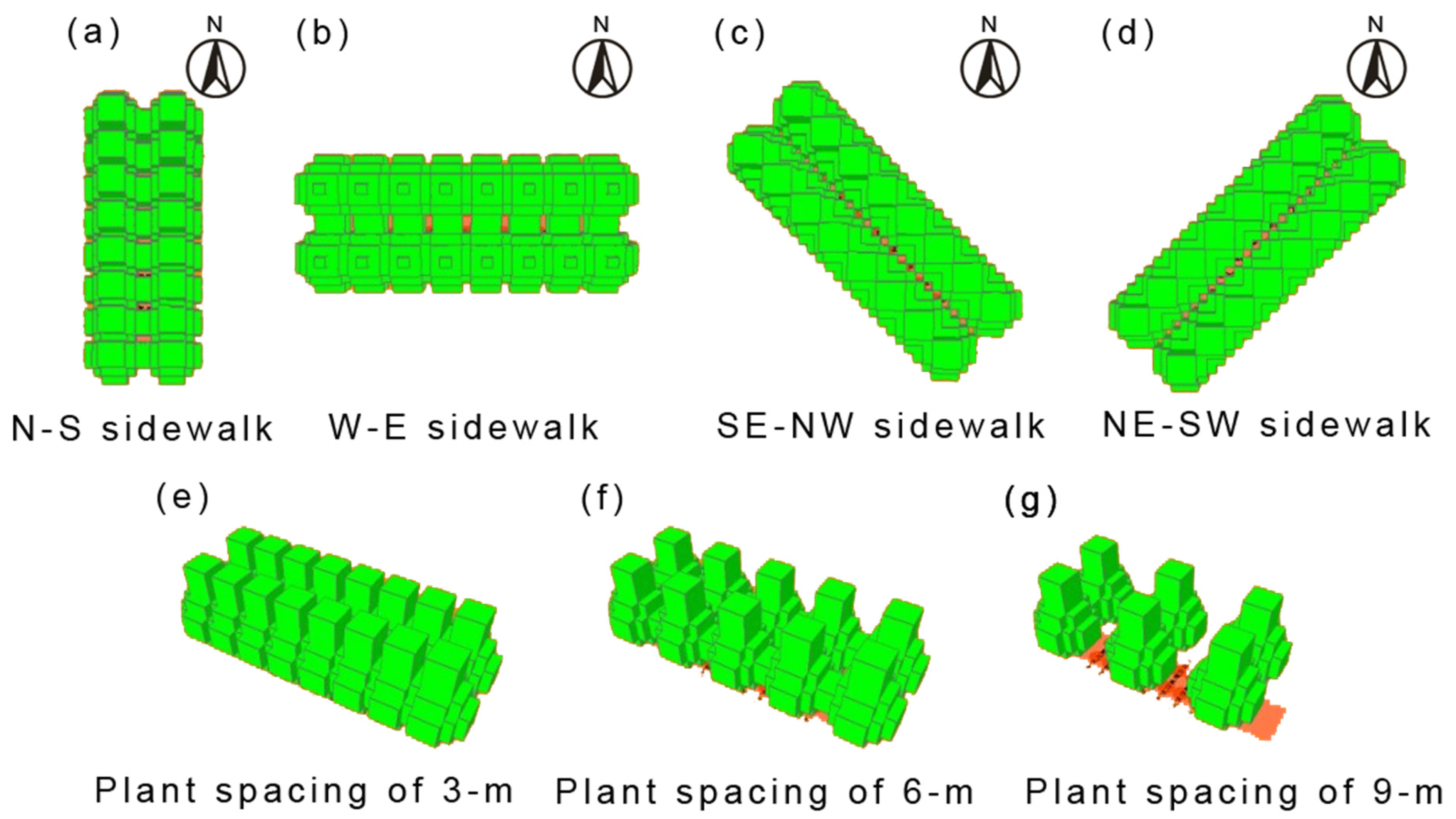
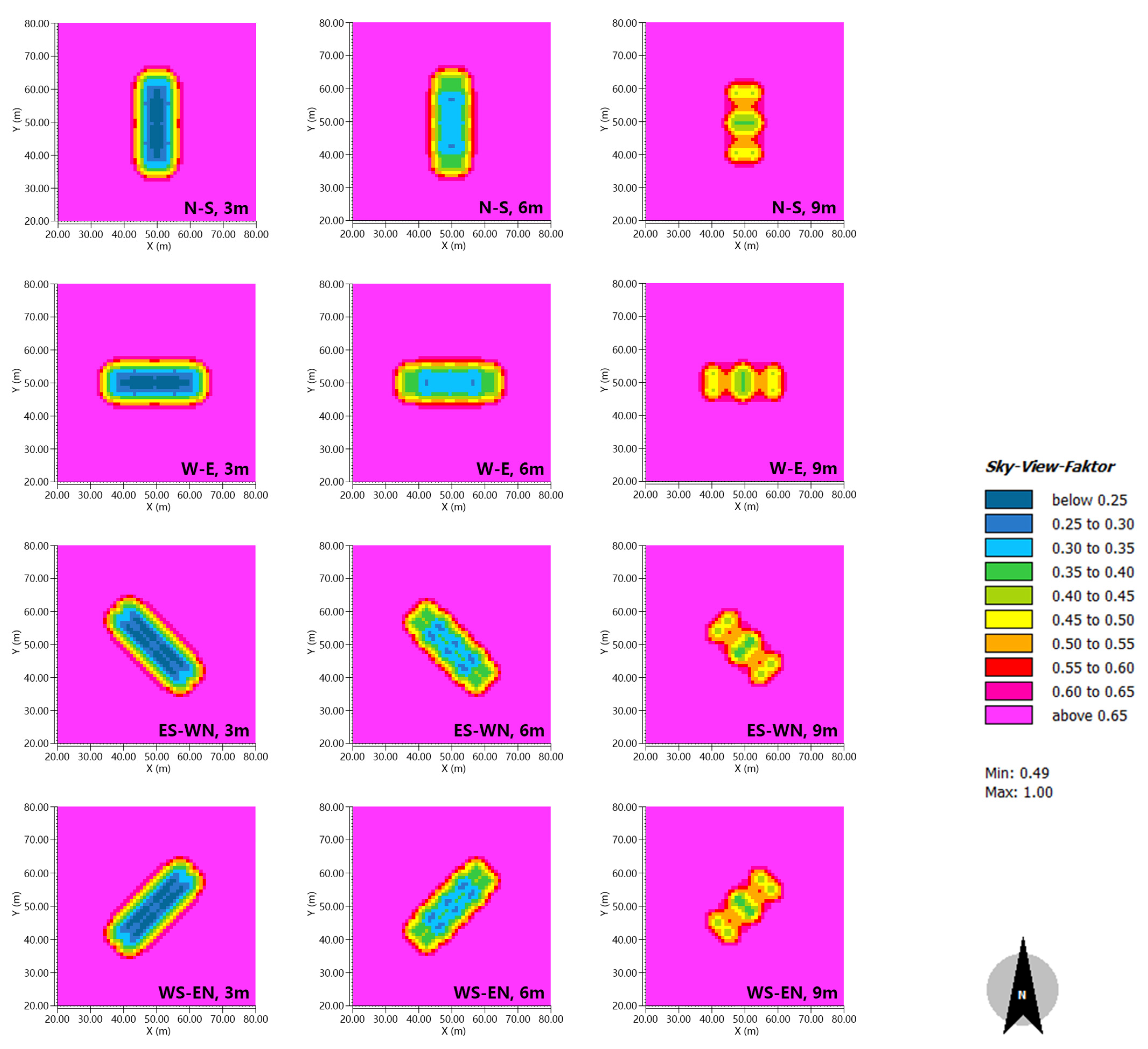
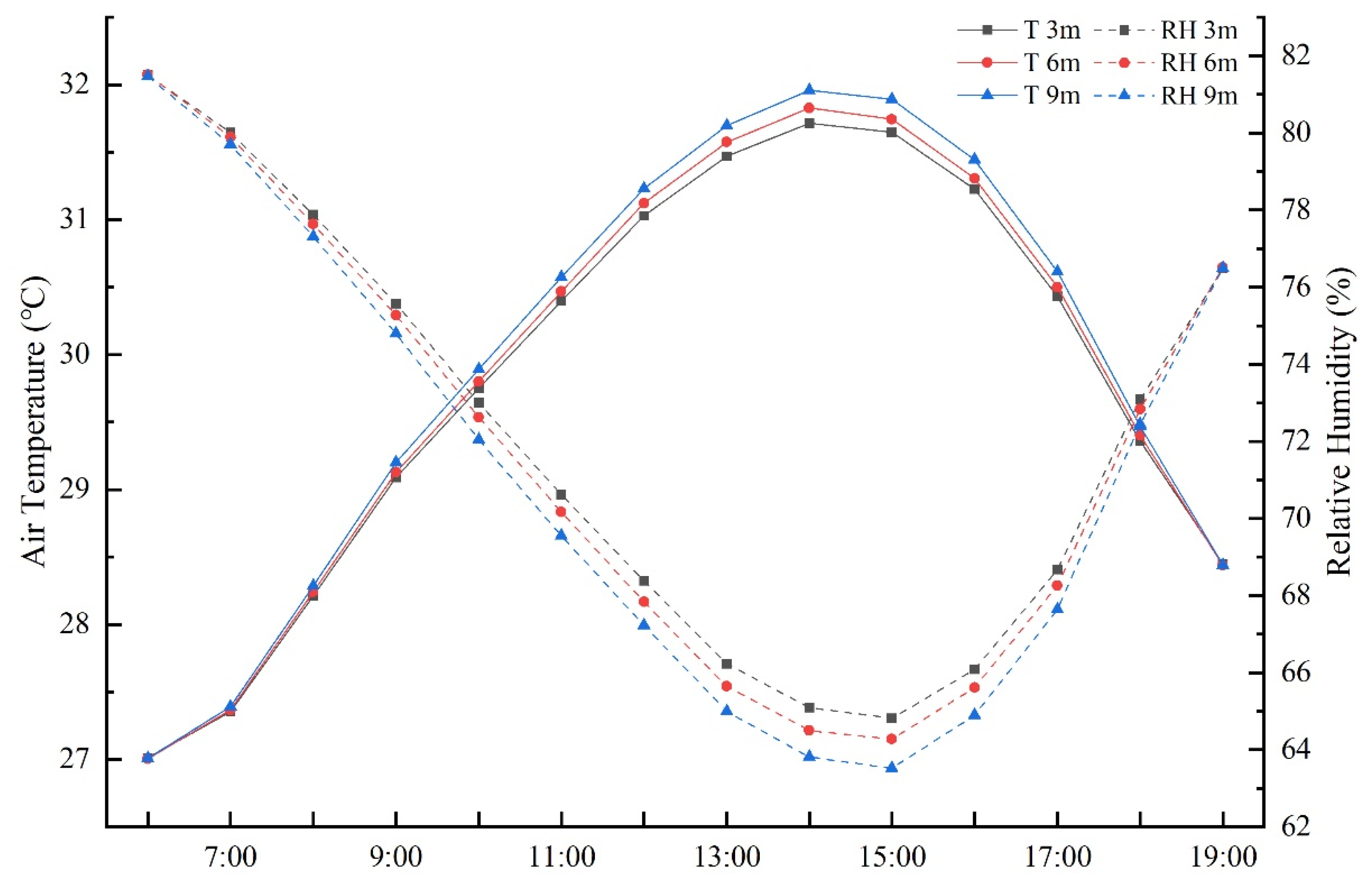

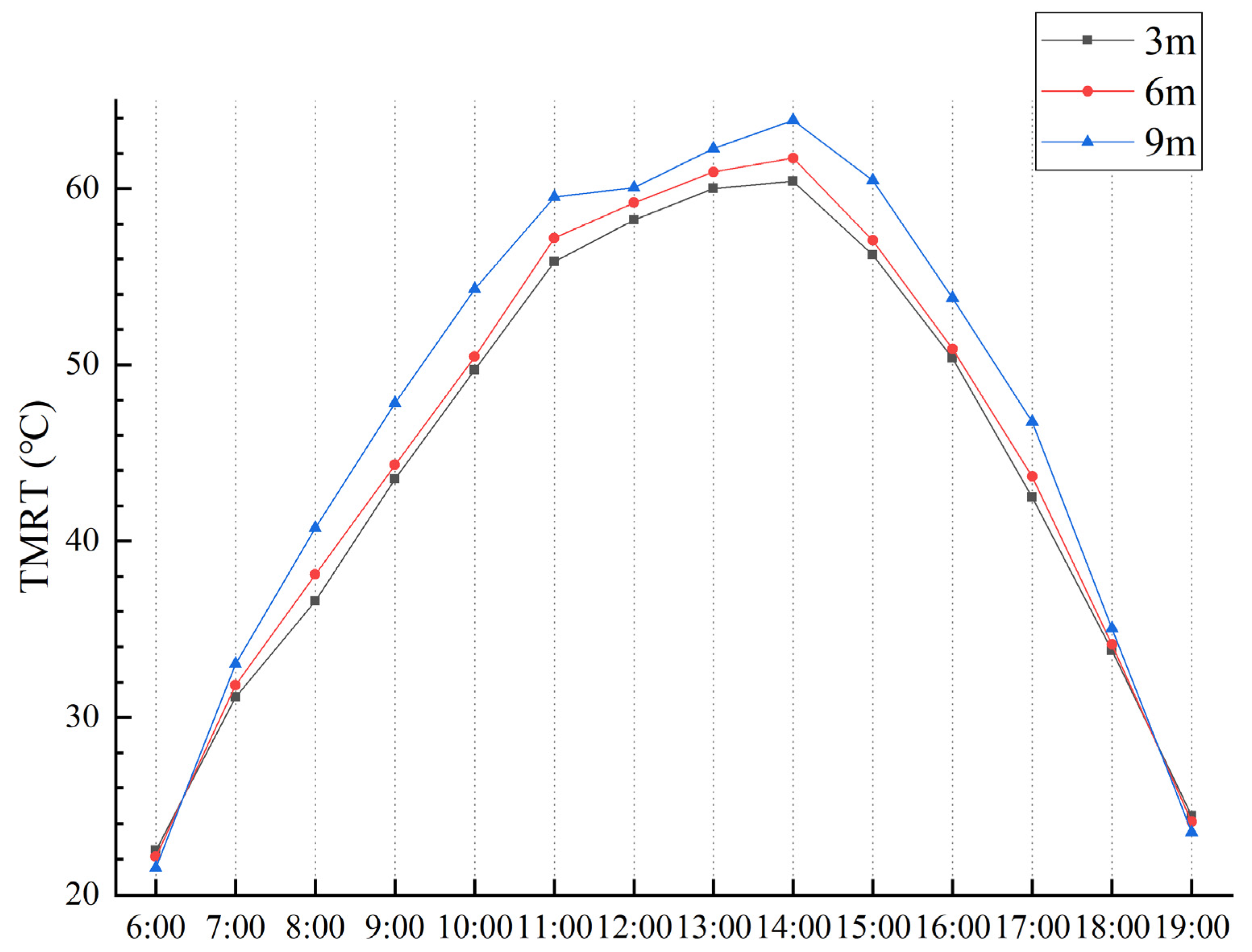

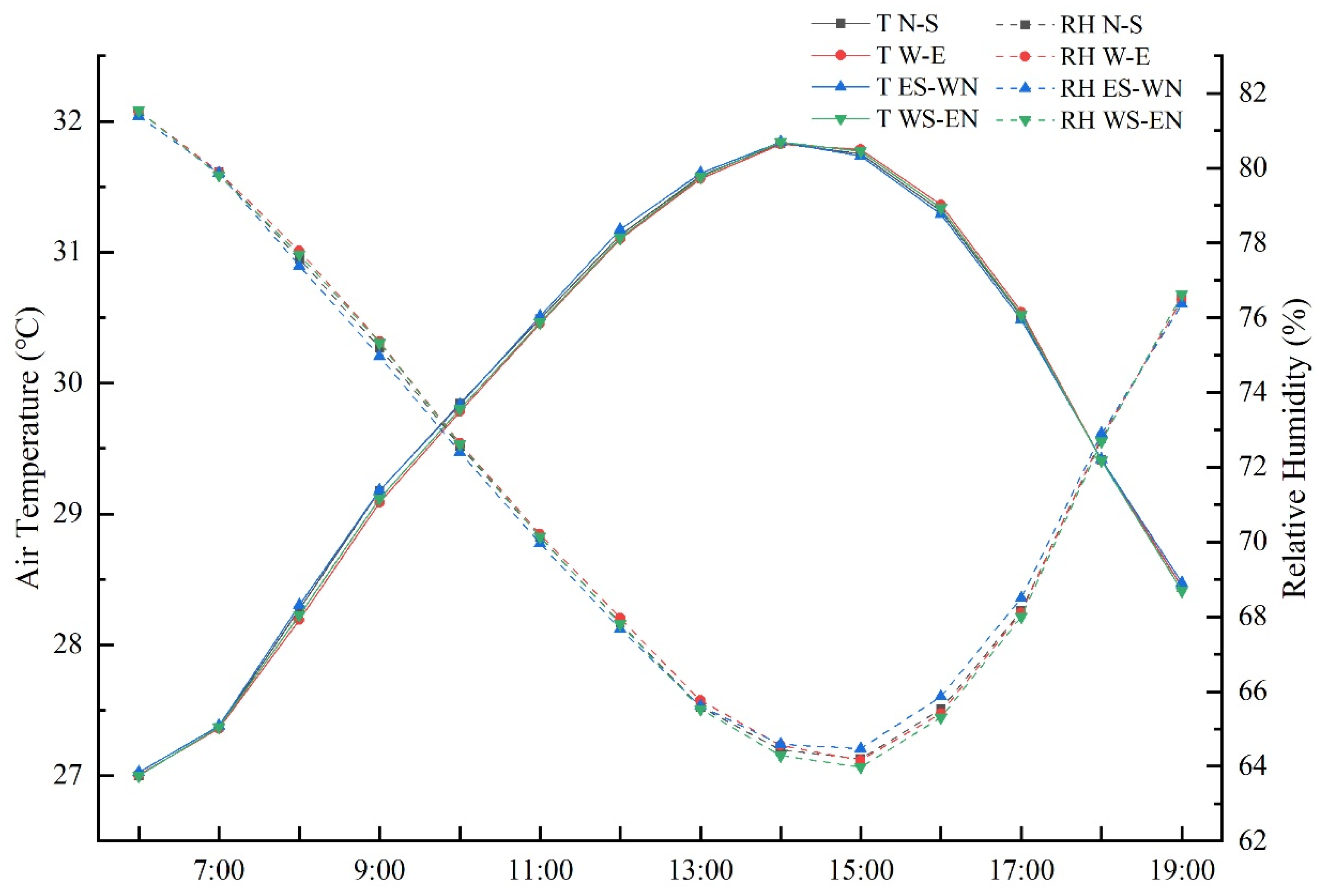


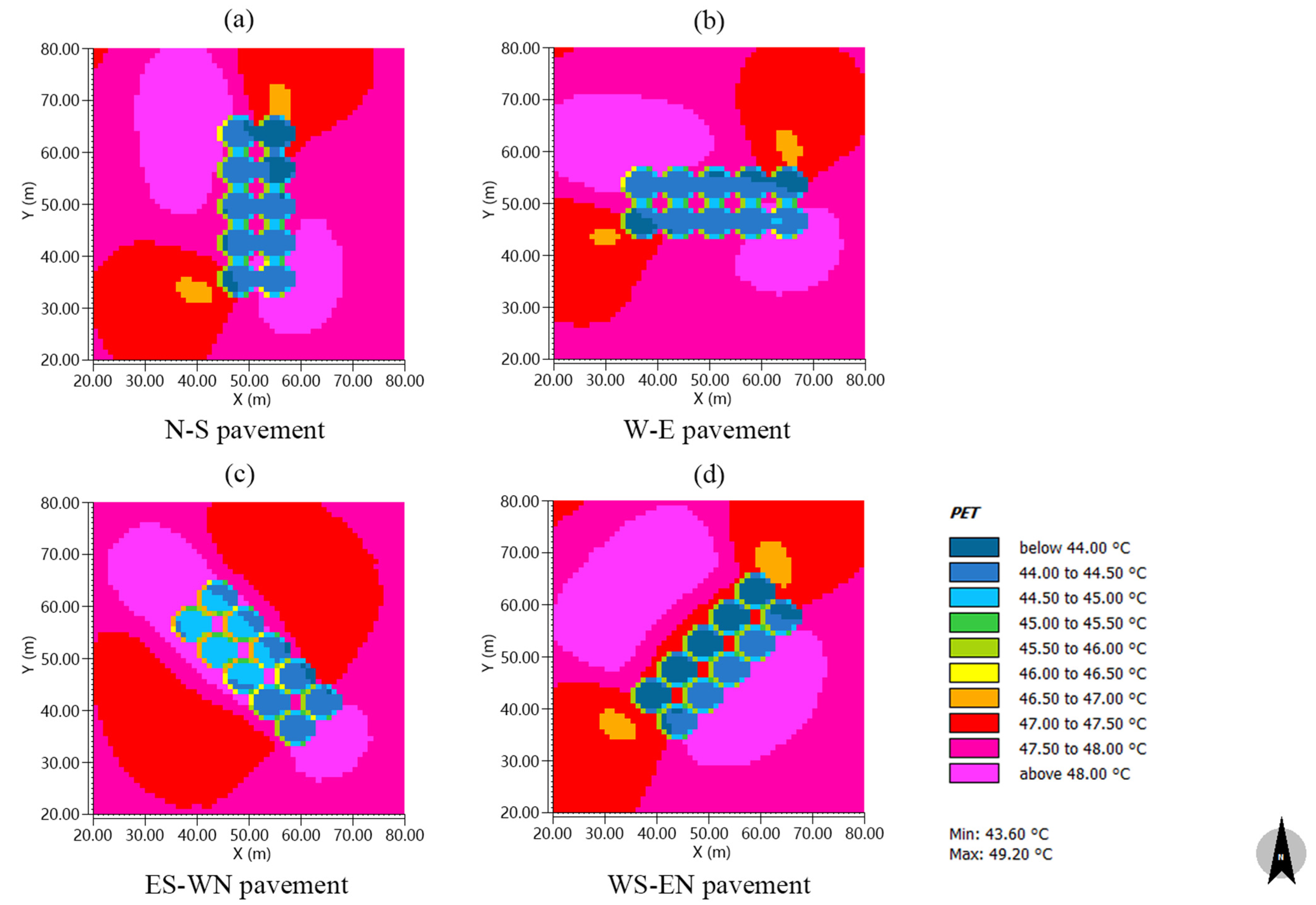
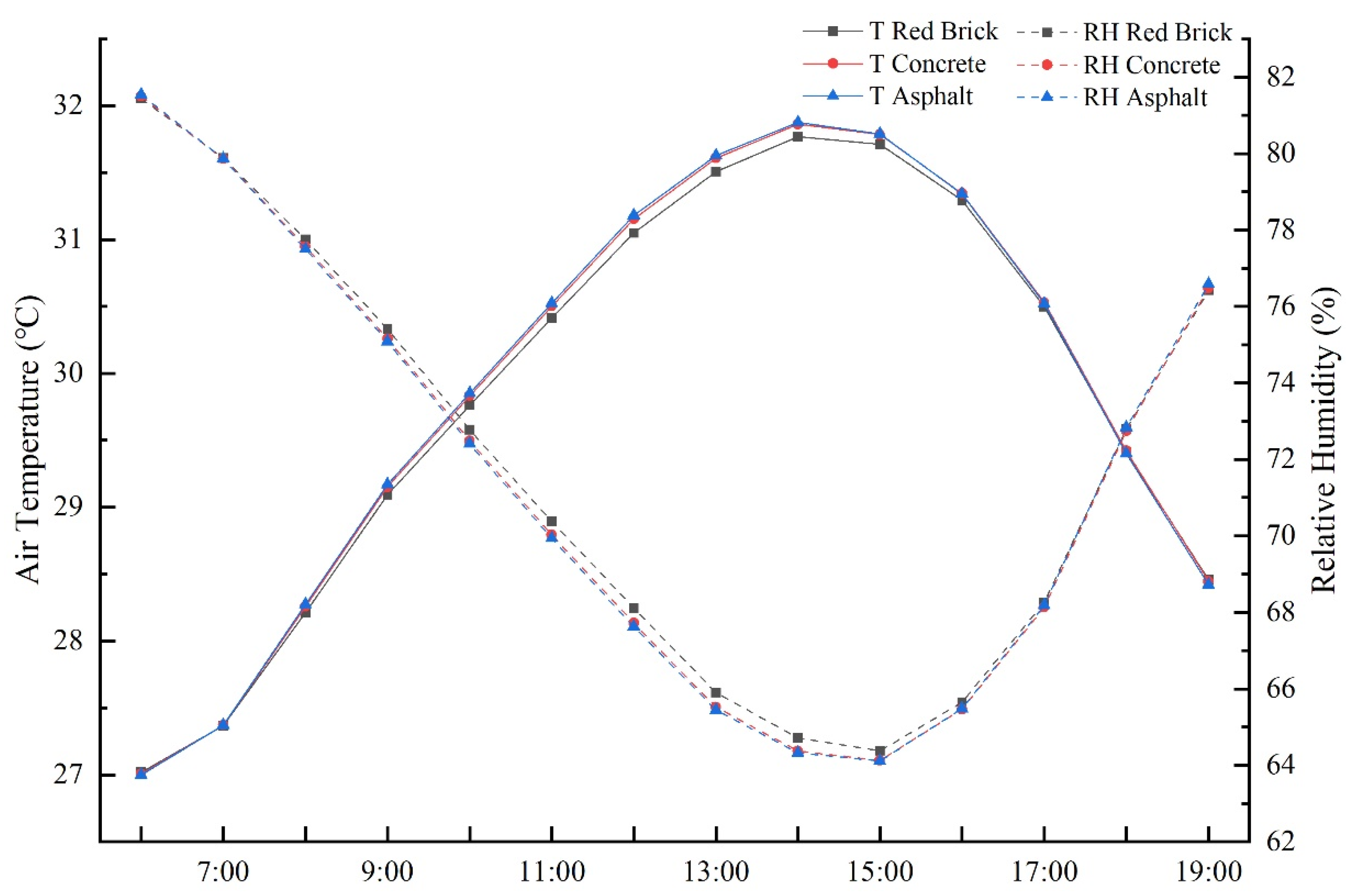

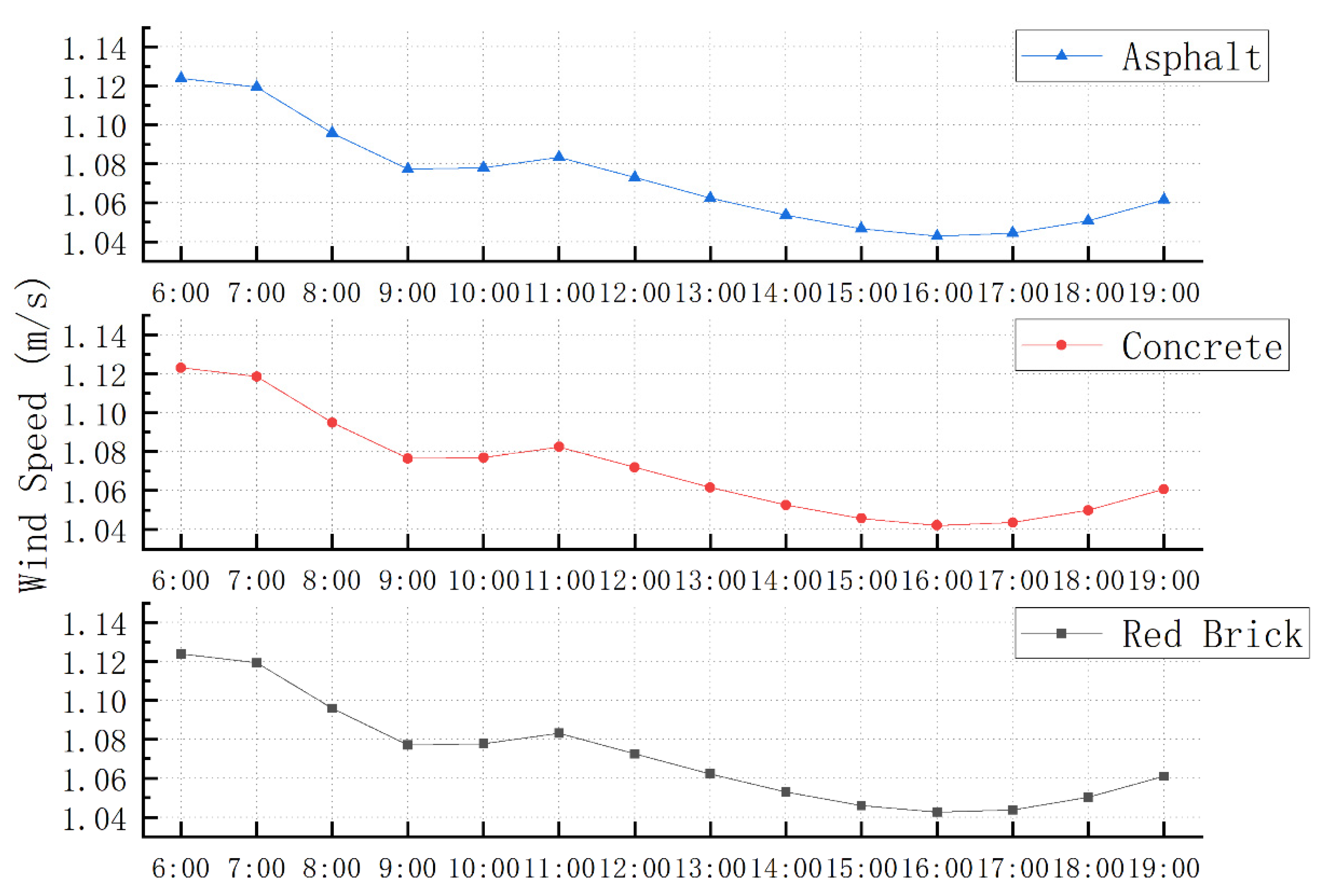

| No. | Road Orientation | Plant Spacing (m) | Underlying Surface Material | No. | Road Orientation | Plant Spacing (m) | Underlying Surface Material |
|---|---|---|---|---|---|---|---|
| A1 | N–S | 3 | Red Brick | B7 | SE–NW | 6 | Concrete |
| A2 | W–E | 3 | Red Brick | B8 | NE–SW | 6 | Concrete |
| A3 | SE–NW | 3 | Red Brick | B9 | N–S | 6 | Concrete |
| A4 | NE–SW | 3 | Red Brick | B10 | W–E | 6 | Concrete |
| A5 | N–S | 3 | Red Brick | B11 | SE–NW | 6 | Concrete |
| A6 | W–E | 3 | Red Brick | B12 | NE–SW | 6 | Concrete |
| A7 | SE–NW | 3 | Red Brick | C1 | N–S | 9 | Asphalt |
| A8 | NE–SW | 3 | Red Brick | C2 | W–E | 9 | Asphalt |
| A9 | N–S | 3 | Red Brick | C3 | SE–NW | 9 | Asphalt |
| A10 | W–E | 3 | Red Brick | C4 | NE–SW | 9 | Asphalt |
| A11 | SE–NW | 3 | Red Brick | C5 | N–S | 9 | Asphalt |
| A12 | NE–SW | 3 | Red Brick | C6 | W–E | 9 | Asphalt |
| B1 | N–S | 6 | Concrete | C7 | SE–NW | 9 | Asphalt |
| B2 | W–E | 6 | Concrete | C8 | NE–SW | 9 | Asphalt |
| B3 | SE–NW | 6 | Concrete | C9 | N–S | 9 | Asphalt |
| B4 | NE–SW | 6 | Concrete | C10 | W–E | 9 | Asphalt |
| B5 | N–S | 6 | Concrete | C11 | SE–NW | 9 | Asphalt |
| B6 | W–E | 6 | Concrete | C12 | NE–SW | 9 | Asphalt |
| Simulation Parameter | Input Content |
|---|---|
| Meteorological parameters | Hourly air temperature, relative humidity, and solar radiation data from typical summer days; wind speed of 1.5 m/s, wind direction of 135.0° |
| Surface roughness: 0.1 m | |
| Absolute air moisture content at 2500 m: 10.76 (g/kg) | |
| Initial state of soil | 0–20 cm: 305 k/30%; 20–50 cm: 307 k/40%; under 50 cm: 306 k/50% |
| Ground structure and thermal properties | Concrete pavement: 4 cm concrete—2 cm sand–soil Red tile pavement: 3 cm red tile—1 cm sand–soil Asphalt pavement: 4 cm asphalt—2 cm sand–soil |
| Total simulation time | 14 h (05:00–19:00 h) |
| Planting Distance (m) | SVF < 0.3 | 0.3 < SVF < 0.5 | SVF > 0.5 |
|---|---|---|---|
| 3 | 62.9% | 33.88% | 3.22% |
| 6 | 2.14% | 94.09% | 3.77% |
| 9 | 0.02% | 41.91% | 58.07% |
| Direction | N–S | W–E | SE–NW | NE–SW |
|---|---|---|---|---|
| Average temperature (°C) | 29.87 | 29.85 | 29.88 | 29.85 |
| Temperature difference (°C) | 4.83 | 4.82 | 4.82 | 4.84 |
| Average humidity (%) | 71.56 | 71.62 | 71.57 | 71.52 |
| Humidity difference (%) | 17.32 | 17.37 | 16.91 | 17.56 |
Publisher’s Note: MDPI stays neutral with regard to jurisdictional claims in published maps and institutional affiliations. |
© 2022 by the authors. Licensee MDPI, Basel, Switzerland. This article is an open access article distributed under the terms and conditions of the Creative Commons Attribution (CC BY) license (https://creativecommons.org/licenses/by/4.0/).
Share and Cite
Li, L.; Zou, Z.; Zhou, T.; Zhou, X.; Li, Q. Simulation and Analysis of Influencing Factors of Pavement Thermal Environments in Guangzhou. Sustainability 2022, 14, 7251. https://doi.org/10.3390/su14127251
Li L, Zou Z, Zhou T, Zhou X, Li Q. Simulation and Analysis of Influencing Factors of Pavement Thermal Environments in Guangzhou. Sustainability. 2022; 14(12):7251. https://doi.org/10.3390/su14127251
Chicago/Turabian StyleLi, Li, Ziqi Zou, Tingting Zhou, Xiaoqing Zhou, and Qingliang Li. 2022. "Simulation and Analysis of Influencing Factors of Pavement Thermal Environments in Guangzhou" Sustainability 14, no. 12: 7251. https://doi.org/10.3390/su14127251
APA StyleLi, L., Zou, Z., Zhou, T., Zhou, X., & Li, Q. (2022). Simulation and Analysis of Influencing Factors of Pavement Thermal Environments in Guangzhou. Sustainability, 14(12), 7251. https://doi.org/10.3390/su14127251






